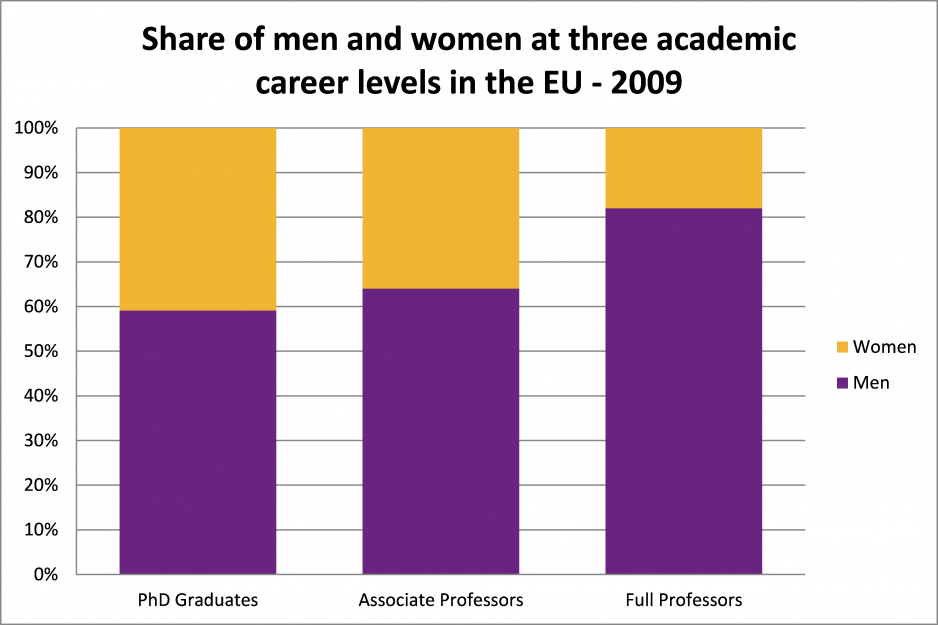
5 facts on women in academia: Is gender parity really around the corner?
Despite considerable progress over the last few decades, even in academia, women continue to face barriers to selection, promotion, recognition in work. In honor of the International Women's day campaign to #PledgeforParity, we bring you 5 startling facts on the progress of gender parity from the ivory tower.
Academia: a world of research and innovation, filled with bright minds formulating and testing new theories, searching for patterns and explanations for the world around us. It is a field defined by its drive to push the boundaries of knowledge, and characterised by progress and enlightenment.
But is it truly progressive, or is it still a world of men? Not quite. In the EU, the proportion of female researchers has been growing 5.1% annually over 2002-09, compared to 3.3% annually for men. In the UK, 22% of professors were women in 2013-14, compared to 15% in 2003-04.
Positive as they are, these trends mask the broader picture. Barriers to women’s careers in academia persist, and not just in the notorious STEM (science, technology, engineering, and mathematics) fields. Here are five facts that illustrate why we are still far from parity.
The 'Glass Ceiling'
 Figure 1: Declining representation of women in later-stage career posts in academia[/caption]
Figure 1: Declining representation of women in later-stage career posts in academia[/caption]
Source: European Commission 2009
This graph compares the share of men and women represented across three career levels in European universities in 2009. It shows clearly the continued existence of the infamous glass ceiling. As might be expected, as we move further along the career or timescale, female representation declines markedly, with fewer than 20% of full professors being women.
One reason might be the lack of women on committees that determine career promotions in academia. This is still an ongoing debate as research has not yet fully demonstrated the undisputable benefits of increasing the number of women on career decision-making groups. Zinovyeva and Bagues use an opportunity from a randomised natural experiment in Spain, to demonstrate that for high-level academic promotions, each additional female in a committee of 7 evaluators increased the chances of success of female applicants by 14%. Whether this is a truly beneficial mechanism to promote the career advancement of women or not, improving gender-balances on decision-making committees, if only for their own parity purposes.
To self-cite or not?
Women tend not to self-promote as much as men. The numbers suggest that only 21% of women self-cited their own work, compared to 31% of men. This has a direct impact on women’s careers in academia, as the number of peer-reviewed publications and citations are the two key criteria taken into account for promotions. This is a classic catch-22. Negotiating and self-promoting by women are also judged to be negative traits by both men and women. Research shows that women, in academia and beyond, are either liked or respected, but not both (Cuddy, Fiske and Glick 2004).
This is a tricky problem to solve. Waiting for society to change their negative view of women self-promotion is not a short-term solution, albeit highly desirable long term one. In the short run, it lies in the hands of women to ensure they self-promote more.
Can female professors have it all?
“The majority of women who achieve tenure have no children […] at any point in time after the PhD”. - Mason & Goulden (2003)
Another systemic and socially constructed challenge for women in academia is motherhood. Most women working in academia operate by the “productive caregiving bias avoidance” strategy, in an effort to avoid being judged negatively on their productivity if they have children. Research shows that mothers tend to be seen as less competent, less committed, less likely to be hired and have lower starting salary recommendations compared to non-mothers (Corell, Benard, and Paik 2007; Cuddy, Fiske and Glick 2004). Drago et al. and Mason and Goulden found that women who want children are usually faced with that choice during their pre-tenure position. At the end of their PhDs (usually late 20s) women have an average of 6 years to establish themselves as influential academics through publications and citations, and cannot therefore take time off work to have children. If they do, they risk falling behind on the career track (or, simply have to quit sleeping).
The system of strict tenure is therefore not appropriate for gender diversity in academia. This is a systemic barrier which would be easily lifted by providing more flexible career and tenure tracks and more family-supportive work environments.
Everyone's a critic
Women tend to be judged more severely by their students. On Ratemyprofessor.com for instance, women are more likely to be labelled “emotional”, “annoying” or “unfair”, and less likely to be described as “genius’”, “interesting” or “influential”. Women are also more likely to be described as “helpful”, “pleasant” and slightly less likely to be labelled as “experts” or “experienced”[1].
In our socially constructed gender norms, we expect women to have certain characteristics and behaviours (such as being respectful and caring). If they don’t, we tend to judge them negatively for it (Sandberg, 2013).
Women not only face systemic challenges in their academic careers, but they also have to fight inherent socially constructed gender biases from their students and colleagues (both male and female). This is true in other fields, but in Academia the relevance is particularly important as reviews directly influence promotions and salaries. Not all biases can be corrected, but blinded evaluation of applicants, for positions and grant funding for example, could go a long way in reducing gender bias effects on women careers’ opportunities.
Overburdening the few
“If it has got the word ‘computer’ in it, […], I am on that panel because my boss likes to see a female computer scientist […] out there, and I get stuck on a committee”. - Focus Group 2
During focus groups held with female academics by the Center for WorkLife Law, the study found women tended to stretch their workloads further by agreeing to participate in committees or speaking on conference panels. Interestingly there is not much research done on these aspects of women in academic careers, although multiple focus groups discussions in various settings corroborate this observation (see also An Assessment Of The Academic Climate For Faculty At UCLA, 2003).
A by-product of the effort to increase the representation of women on committees, seems to be that women are more likely to sit on multiple committees and are stretched for time trying to accommodate their teaching and work productivity as well (peer-reviewed publications and citation). Wouldn’t it just be simpler to hire and promote more women?
Conclusion
Do we want to keep missing 50% of our potential talent in research because the institutional career tracks and human resources of academia remain stuck in the past? There has clearly been some improvement in the past two decades in the share of female academics, but this is despite the system, not thanks to it. Researchers in academia shape how future generations think, conduct cutting-edge research, and apply its findings. Academia should be a leader in gender parity, not only for the sake of its own women academics, but to pave the way for society as a whole.
Notes
[1] An assistant professor at Northeastern University, has created an online tool based on professor reviews on RateMyProfessor.com. This provides interesting insights into the frequency that a word has been used to rate male and female professors.
Sandberg, S. (2013). Lean in: Women, work, and the will to lead (First edition.). New York: Alfred A. Knopf.

